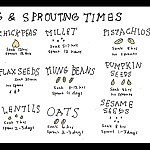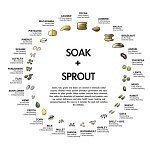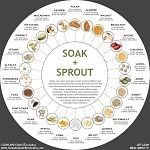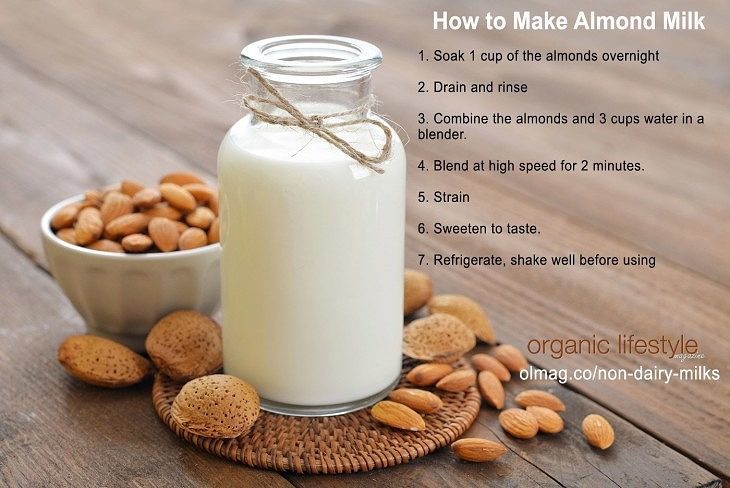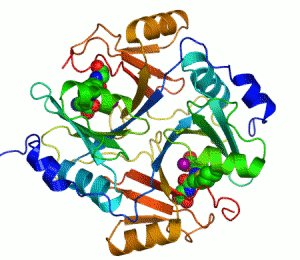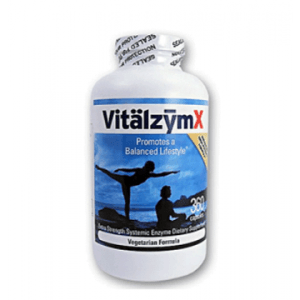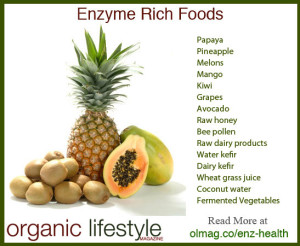You Need Sulforaphane – How and Why to Grow Broccoli Sprouts
Brain Enhancing, Fat Burning, Cancer Preventing, DIY Homemade Supplementation
It is not another drug or folk remedy. You can prevent many forms of cancer, improve gut health, establish healthy body fat composition, enhance brain function, detoxify your cells, and reduce depression with this one miracle compound.
It’s called sulforaphane, and it is naturally produced when cruciferous vegetables are damaged. We initiate the reaction that creates sulforaphane with the process of chewing, which allows us to reap a plethora of benefits that make the scientific research on sulforaphane look like a late night TV ad.
The Scientific Sales Pitch
Although there are many proposed effects of sulforaphane, let’s stick with what has been studied. Sulforaphane has been shown to prevent the growth of many cancers including breast, prostate, colon, skin, lung, stomach, and bladder cancer. The risk of common diseases like diabetes, heart disease, gastric disease, neurodegenerative disease, ocular disease, and respiratory diseases are reduced with the consumption of sulforaphane as well. Even behavioral disorders like autism have been helped with sulforaphane supplementation. And if that isn’t enough, sulforaphane has been shown to decrease fat gain and improve body composition in mice. All this is possible because sulforaphane stimulates protective and detoxifying mechanisms in the cells. This allows the cells to eliminate environmental toxins like mercury and air pollutants from the body and repair themselves from the damage caused by oxidative stress.
The Best Source of Sulforaphane
With positive and protective effects on almost every cell in the body, sulforaphane is like a health insurance policy for your cells. This compound can be found in raw or minimally cooked cruciferous vegetables like broccoli, kale, cauliflower, and Brussels sprouts.
It is important to note that sulforaphane cannot be produced from vegetables that are cooked at a temperature above 158 degrees Fahrenheit. This is because the enzyme that helps create sulforaphane is deactivated when is heated above 158 degrees Fahrenheit.
The enzyme that helps create sulforaphane may also become less active in mature cruciferous vegetables, so it is uncertain how much sulforaphane you will actually get from mature plants. This is where crucifer sprouts save the day. Due to their increased enzyme activity, crucifer sprouts are the best source of sulforaphane. But one sprout, in particular, may provide the most sulforaphane of them all. That sprout is the broccoli sprout.
Where To Get Broccoli Sprouts
After seeing the benefits of broccoli sprouts it is tempting to add that $10 bottle of broccoli sprout capsules to your cart, but don’t let the tempting price fool you. At $10 per bottle, you are spending 20x more than if you bought broccoli sprouts in the store, and supplements can’t even guarantee that they actually have any sulforaphane or enzyme activity.
With store bought broccoli sprouts you can at least guarantee that you are getting sulforaphane in your diet. However, store bought broccoli sprouts will run you about $1 per ounce when you can easily grow them at home for the cost of ~9 cents per ounce.
With one 64 oz mason jar, a seed strainer lid, broccoli seeds, a glass bowl, and water you can grow up to 15 pounds of sprouts per pound of broccoli seeds. That means you can have a half pound of sprouts every week for over 6 months. Fifteen pounds of broccoli sprouts would cost you $240 if you bought them in the store or almost $5,000 in capsule form, and you can get them for less than $50.
How to Grow Your Own Broccoli Sprouts
Growing your own broccoli sprouts is simple and easy. It doesn’t require gardening skills, and after less than a week you can have up to half a pound of delicious broccoli sprouts for the cost of less than a dollar.
Here is what you need:
- Organic broccoli seeds for sprouting (~$15 per pound)
- A 64-ounce mason jar (~$10 per jar)
- Strainer sprouting lids that fit the mouth of your jar (~$9 per lid)
- A glass bowl
- A cool, dark place
- Optional: full spectrum light
- Optional: salad spinner
Estimated yield: 3 tablespoons of seeds will most likely sprout to a half pound of broccoli sprouts in about 5-7 days.
Step by Step Guide to Sprouting Your Broccoli Seeds
Step 1
Put 3 tablespoons of broccoli seeds in your mason jar, cover the seeds with cool, distilled water or spring water (60-70 degrees Fahrenheit), and swish the water around gently. Put your mason jar, with the sprouting lid on, in a cool dark place for 6-12 hours to allow the seeds to soak.

Step 2
Drain off the water by tipping the mason jar to let the water pass through the strainer. Take the glass bowl and rest your mason jar inside of it so that the remaining water can drain. Put it in a cool dark place for 8-12 hours to let the seeds drain and sprout.

Tip: make sure the jar is tipped enough so that the seeds can drain and have adequate airflow. The most common cause of poor sprouting is inadequate drainage.
Step 3
Rinse the seeds 2x daily and put the jar back in the bowl in a cool dark place so it can drain. It might help to set reminders on your phone.
Here’s what mine looked like 60 hours after the beginning of the first rinse:

Tip: Try not to expose them to too much light until most of them are sprouted with tiny yellowish leaves.
Step 4
After 3 to 4 days you will notice white sprouts with tiny yellowish leaves coming from the seeds. When this happens for most of your seeds, you can begin exposing them to indirect sunlight or a full spectrum light bulb so that they can start to green up. Continue to do the same rinsing process as before.
84 hours after the beginning of the first rinse:

Step 5
After a day or two of light exposure, rinse them once again, and let them drain overnight. The next morning they will be ready to eat!
After the first day of sun exposure:

The finished product, about 6 ounces of broccoli sprouts from 2 and a half tablespoons of broccoli seeds:

Bonus Step: How to Increase Sulforaphane content by 3.5x
Studies have actually been conducted to find out how to increase the bioavaliability of sulforaphane from broccoli sprouts. One study found that If you want to get the most out of your broccoli sprouts, you must never expose them to temperatures greater than 70 degrees Celsius (158 degrees Fahrenheit). However, if you let them sit in 65 to 70 degree Celsius (149 to 158 degrees Fahrenheit) water for 10 minutes, you can increase sulforaphane content by around 3.5 fold. The greatest increase was found at 70 degrees Celsius (158 degrees Fahrenheit) with a rapid decrease when the sprouts were exposed to greater temperatures.
To try this broccoli sprout hack at home all you need is a pot, thermometer, a glass bowl, a timer, water, and your broccoli sprouts. Put your broccoli sprouts in a glass bowl while you heat up the water in the pot until it reaches 70 degrees Celsius. Cover your sprouts with the water and set your timer for ten minutes. Check the temperature of the water that the sprouts are in every couple of minutes and add 70 degree Celsius water to the broccoli sprouts periodically to maintain the temperature between 65 and 70 degrees Celsius. After 10 minutes, drain the sprouts, pat they dry, eat them, add them to a smoothie, or store them in the refrigerator.
If that description was to confusing, check out how Dr. Rhonda Patrick hacks her broccoli sprout sulforaphane content:
How to Store Your Sprouts for up to Six Weeks
To keep the sprouts fresh and nutritious for six weeks follow these steps:
- Eight to twelve hours after the final rinse and drain, pat your sprouts dry and/or use a salad spinner until the sprouts are reasonably dry. Nothing kills produce quicker than refrigerating it wet.
- Put the sprouts in a plastic bag or container that will ensure minimal exposure to air. If they are exposed to too much air they may dry out completely.
- Refrigerate them for up to six weeks and eat them whenever and however you like.
Enjoy!
Recommended Reading:
- Fight Cavities and Gingivitis Naturally With Homemade DIY Oral Health
- Total Nutrition – Make your own Homemade Multivitamin and Mineral Formula
- Natural, Safe Sunscreen Options with Homemade Sunscreen Recipe
- How To Make Natural Body Butters That Actually Moisturize Your Skin
Sources:
- Keap1-Nrf2 Signaling: A Target for Cancer Prevention by Sulforaphane — NCBI
- Sulforaphane treatment of autism spectrum disorder (ASD) — NCBI
- Sulforaphane, a Dietary Component of Broccoli/Broccoli Sprouts, Inhibits Breast Cancer Stem Cells — NCBI
- Dietary Sulforaphane in Cancer Chemoprevention: The Role of Epigenetic Regulation and HDAC Inhibition — NCBI
- Frugal Chemoprevention: Targeting Nrf2 with Foods Rich in Sulforaphane — NCBI
- Oxidative Stress and Neurodegenerative Diseases: A Review of Upstream and Downstream Antioxidant Therapeutic Options — NCBI
- Sulforaphane, a phytochemical in broccoli sprouts, ameliorates obesity — Science Daily
- Sulforaphane improves cognitive function administered following traumatic brain injury — Science Direct
- Neuroprotective Effects of Sulforaphane on Cholinergic Neurons in Mice with Alzheimer’s Disease-Like Lesions — NCBI
- Broccoli sprouts: an exceptionally rich source of inducers of enzymes that protect against chemical carcinogens. — NCBI
- Heating decreases epithiospecifier protein activity and increases sulforaphane formation in broccoli. — NCBI
- Refrigerating — Sprout People
- Potential health benefits of sulforaphane: A review of the experimental, clinical and epidemiological evidences and underlying mechanisms — Academic Journals
- Broccoli sprouts: an exceptionally rich source of inducers of enzymes that protect against chemical carcinogens. — NCBI
